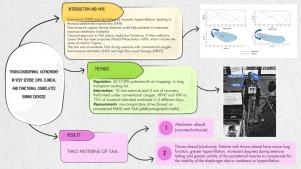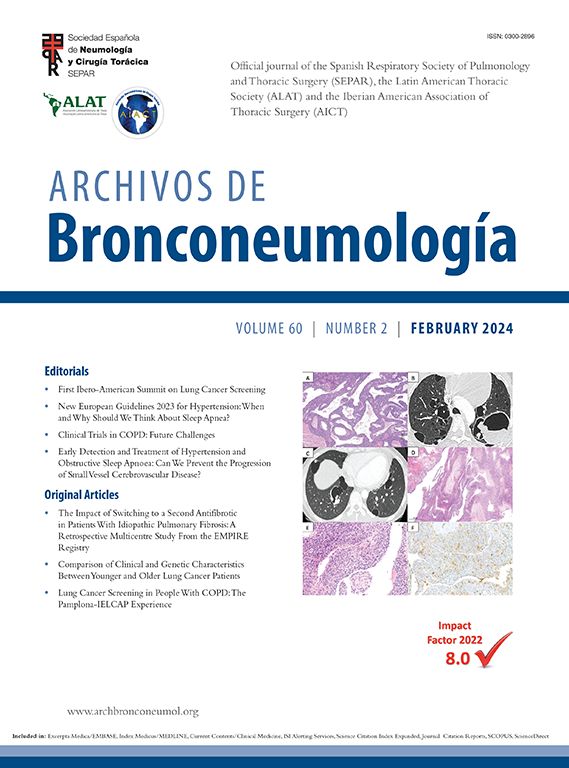Thoracoabdominal Asynchrony in Very Severe COPD: Clinical and Functional Correlates During Exercise
IF 9.2
3区 医学
Q1 RESPIRATORY SYSTEM
引用次数: 0
Abstract
Introduction
Patients with severe Chronic Obstructive Pulmonary Disease (COPD) often experience breathlessness and exercise limitations due to expiratory flow limitation. Pulmonary rehabilitation programmes, including exercise with non-invasive ventilation (NIV) or high-flow nasal therapy (HFT), aims to improve quality of life and exercise tolerance. This study investigates the relationship between thoracoabdominal asynchrony (TAA) during supported (NIV and HFT) and unsupported (conventional oxygen therapy – COT) exercise and clinical and functional parameters in severe COPD patients awaiting lung transplantation.
Methods
This experimental, longitudinal, prospective, controlled study included 20 severe COPD patients on the lung transplant waiting list. Patients underwent three constant load exercise tests under COT, NIV, and HFT conditions. TAA was measured using respiratory inductance plethysmography, and neurorrespiratory drive (NRD) was assessed via parasternal electromyography.
Results
Patients exhibited distinct TAA patterns during exercise. Clockwise rotation (thorax ahead) was associated with worse baseline lung function, higher peak exercise dyspnoea and higher peak exercise NRD compared to counterclockwise rotation (abdomen ahead). No significant differences in TAA were observed between the three exercise conditions (COT, NIV, HFT). However, patients with clockwise TAA were more likely to have reduction in breathlessness with NIV compared to COT than those with counterclockwise rotation.
Conclusions
TAA patterns during exercise in severe COPD patients can indicate the severity of lung function impairment and predict severity of exercise induced dyspnoea. Analysis of TAA may predict response to respiratory support modalities and therefore monitoring TAA and NRD should be further studied to allow better tailoring of respiratory support during rehabilitation.

非常严重COPD的胸腹不同步:运动期间的临床和功能相关。
重度慢性阻塞性肺疾病(COPD)患者经常由于呼气流量受限而出现呼吸困难和运动受限。肺康复计划,包括无创通气(NIV)或高流量鼻治疗(HFT),旨在提高生活质量和运动耐受性。本研究探讨等待肺移植的重症COPD患者在有支持(NIV和HFT)和无支持(常规氧疗- COT)运动期间胸腹不同步(TAA)与临床和功能参数的关系。方法:本实验,纵向,前瞻性,对照研究纳入20例肺移植等待名单的重症COPD患者。患者在COT、NIV和HFT条件下进行了三次恒定负荷运动试验。TAA采用呼吸感应容积描记仪测量,神经呼吸驱动(NRD)通过胸骨旁肌电图评估。结果:患者在运动过程中表现出明显的TAA模式。与逆时针旋转(腹部前方)相比,顺时针旋转(胸部前方)与更差的基线肺功能、更高的峰值运动呼吸困难和更高的峰值运动NRD相关。三种运动条件(COT, NIV, HFT)之间的TAA无显著差异。然而,与COT相比,顺时针旋转TAA的患者更有可能减少NIV的呼吸困难。结论:重度COPD患者运动时的TAA模式可提示肺功能损害的严重程度,预测运动性呼吸困难的严重程度。分析TAA可以预测对呼吸支持方式的反应,因此应进一步研究监测TAA和NRD,以便在康复期间更好地定制呼吸支持。
本文章由计算机程序翻译,如有差异,请以英文原文为准。
求助全文
约1分钟内获得全文
求助全文
来源期刊

Archivos De Bronconeumologia
Medicine-Pulmonary and Respiratory Medicine
CiteScore
3.50
自引率
17.50%
发文量
330
审稿时长
14 days
期刊介绍:
Archivos de Bronconeumologia is a scientific journal that specializes in publishing prospective original research articles focusing on various aspects of respiratory diseases, including epidemiology, pathophysiology, clinical practice, surgery, and basic investigation. Additionally, the journal features other types of articles such as reviews, editorials, special articles of interest to the society and editorial board, scientific letters, letters to the editor, and clinical images. Published monthly, the journal comprises 12 regular issues along with occasional supplements containing articles from different sections.
All manuscripts submitted to the journal undergo rigorous evaluation by the editors and are subjected to expert peer review. The editorial team, led by the Editor and/or an Associate Editor, manages the peer-review process. Archivos de Bronconeumologia is published monthly in English, facilitating broad dissemination of the latest research findings in the field.
 求助内容:
求助内容: 应助结果提醒方式:
应助结果提醒方式:


